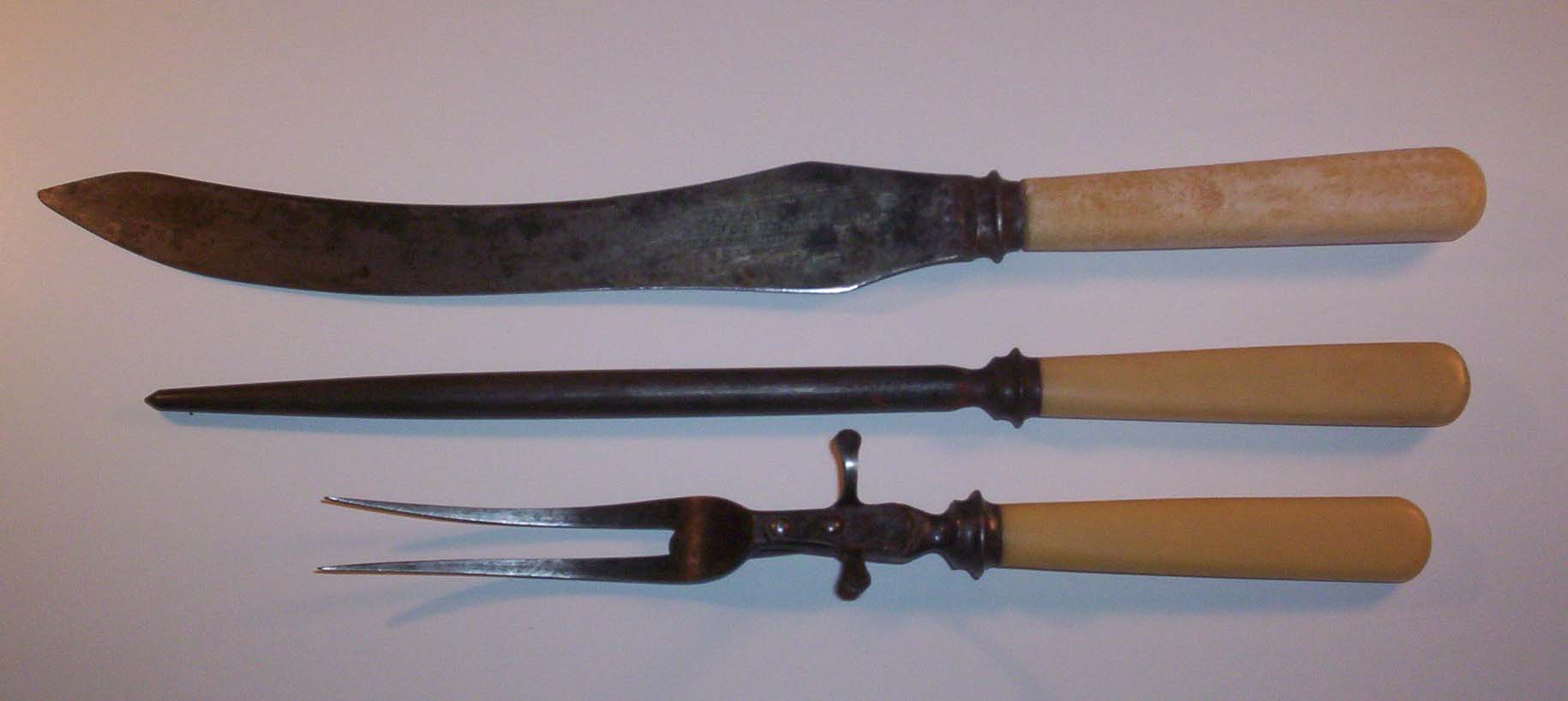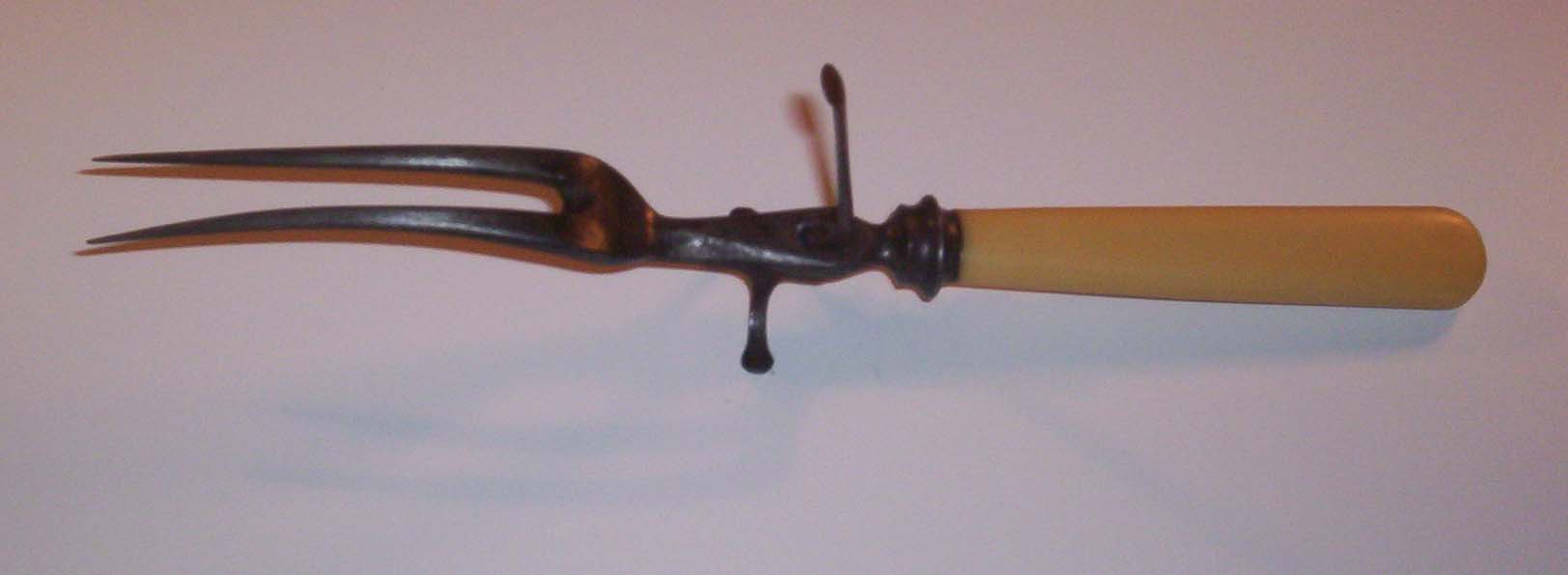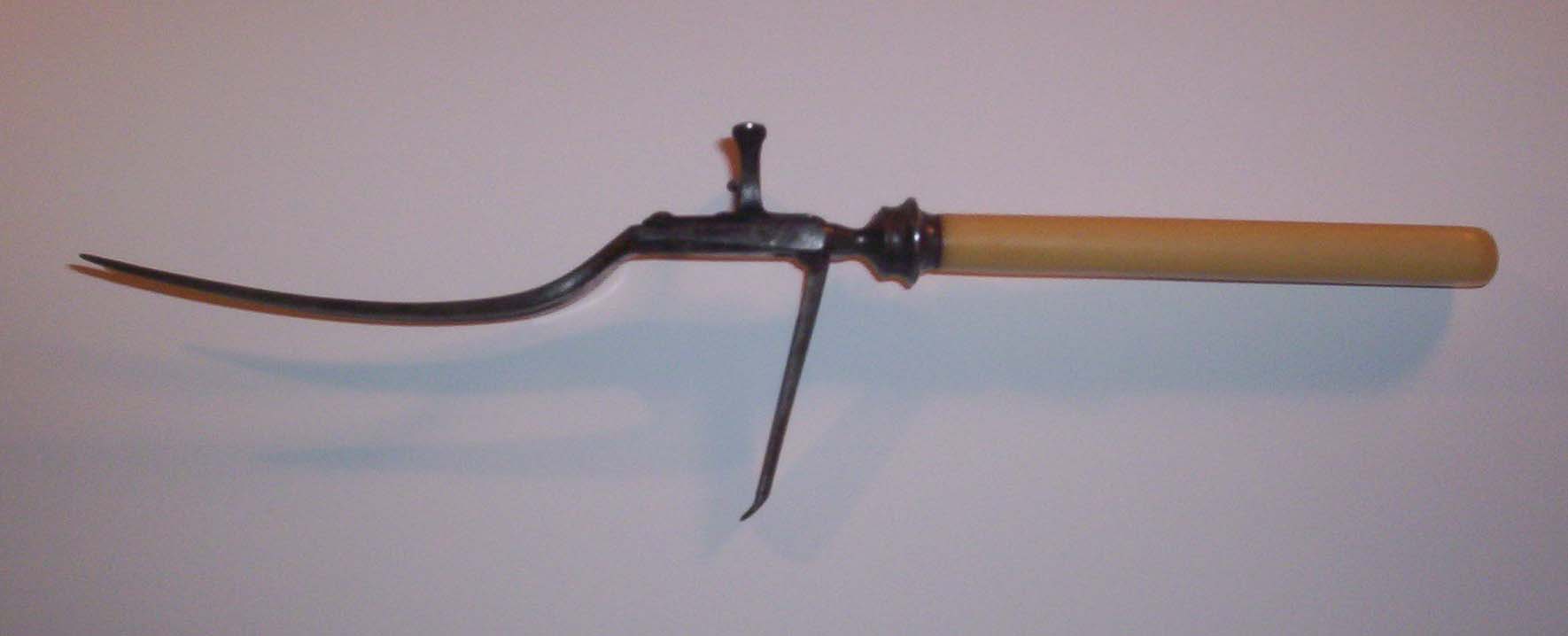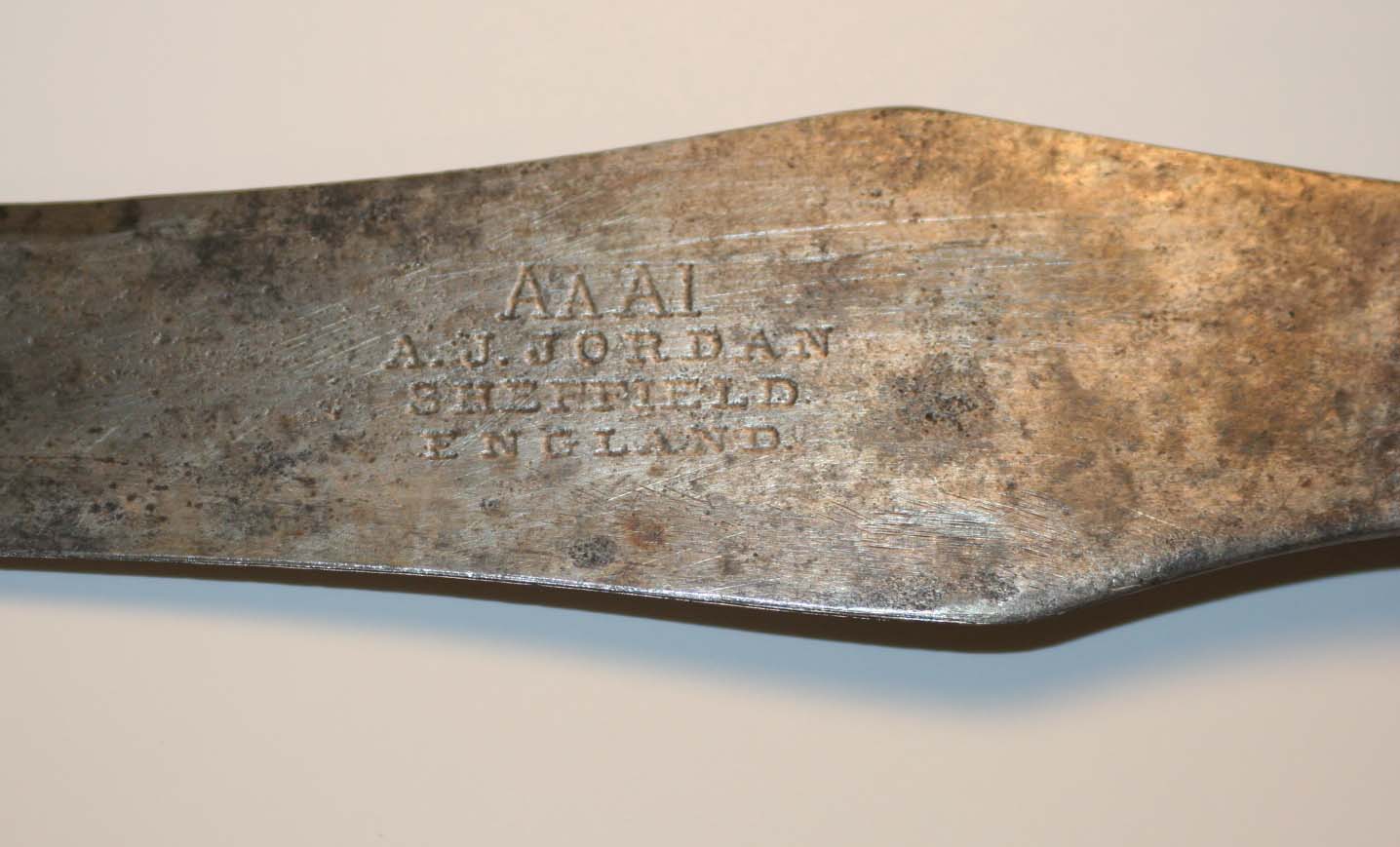Richardson Family
Carving Knife Set
Among the Richardson family heirlooms I inherited from my mother after her death in 2007 is a carving set -- carving knife, fork, and sharpening steel. Here's a photo of the set.
Note the fork has two "ears" sticking out of the top. If the fork is turned over, these ears form a rest. Also, on the back of the fork is a spring-loaded piece of steel whose purpose I can't determine. It may have been used to hold a piece of meat. Here are two photos of the fork.
In this photo the fork is turned upside-down. It is resting on the two "ears" and the spring-loaded thing has been popped up -- it holds itself open.
Here is a side view of the fork. One of the "ears" is hidden behind the one in front; the spring-loaded "finger" is shown clearly.
The knife has a maker's mark stamped or engraved on the blade. Here's a photo of the marking.
The mark reads:
AAA1
A. J. JORDAN
SHEFFIELD
ENGLAND
The material of which the handles are made could be bone or ivory. The handle of the fork has clear striations that run end-to-end. The handles of the knife and steel are made of the same material but I can't make out any striations or pattern in them.
A. J. Jordan
I did several Internet searches for "A. J. Jordan," "A. J. Jordan carving knives," and similar search queries. This is the best I found.
Around 1885...Jordan was to make an astute observation and momentous decision which would catapult his empire to its greatest heights. A.J. came to the firm conclusion that even the best efforts of the knife makers of Germany could not begin to compare with the zenith of quality which had been achieved by the cutlery craftsmen of Sheffield, England. A less ambitious entrepreneur would have settled for simply importing knives made in Sheffield. In fact, at first, it appears that this is exactly what he did. It was his next move, however, that would make him unique in the annals of American cutlery history. A.J. Jordan left America's shores to establish a cutlery of his own in Sheffield! He named his factory the East India Works.... Up to 120 employees were kept busy at the East India Works, skillfully crafting an immense quantity of cutlery bearing the A.J. Jordan AAA1 brand. This production was then shipped to the spacious warehouse and showrooms of the growing empire's St. Louis headquarters.... Henceforth and until the last ten years of his life...he would divide his time between England and America, maintaining a residence on Clarkson St. in Sheffield
-"Clay Cutlery Company and the A.J.Jordan Empire", by C.David Pierce, Knife World, November 2008.
I also found an auction site with a similar carving set for auction, except the handles were stag horn. The auction had this description:
| Up for auction is this complete carving set from A.J. Jordan Sheffield, England. A very old set that is still together. Above the A.J. Jordan Sheffield, England are the letters, AAA1. Goins Encyclopedia of Cutlery Markings dates this set between 1878 and 1926. The AAA1 mark was first used in 1886. The AAA1 indicates this was an import company in St.Louis, Missouri. Andrew J. Jordan was the founder. Much of the company's trade was with the Indian Tribes such as the Blood,Crow, Blackfeet,and River Crow. The set does have tarnish and some pitting on all three pieces. There are no cracks or chips in the stag handles. All three pieces are in excellent condition for their age. Please email with any questions that you may have. Thank you for looking. |
What to make of this
First, I need to say the set is in use. We use the set to carve meat -- turkey, roast, and the like -- and it works just fine. The knife holds an edge and the sharpening steel touches up the edge as needed.
It appears from the two Internet sources quoted above that this set was manufactured in Sheffield, England, by A. J. Jordan's factory and shipped to the US for sale through his distribution center in Saint Louis. The auction listing states the AAA1 mark was first used in 1886. I found several Internet references indicating Jordan's knives were imported until 1926. If A. J. Jordan imports stopped in 1926, there still could have been knives and carving sets for sale afterwards from stock on hand before 1926. Thus, this carving set could have come into my family's possession anytime after 1886.
Richardson? Dudding? White?
As of February 2013, I have these theories about the provenance of the set. Because the set was in my mother's possession, I assume it came from the Richardson or Dudding families. The carving set could have come from these of my ancestors.
-
My Richardson great-grandparents are Reverdy Hunter Richardson (b. 1 Sep 1864 - d. 12 Apr 1916) and Martha "Mattie" Coon (b. 28 Jan 1861, d. 21 Jan 1901). They were married 26 Nov 1885. The set could have belonged to them.
-
After his first wife, Mattie Coon, died in January 1901, Reverdy H. Richardson married Nettie Ethel DuBose (b. 10 May 1882, d. 8 Feb 1949) on 10 January 1906. The set could have belonged to them.
-
My Dudding great-grandparents are Maurice Dudding (b. 8 Mar 1869, d. 26 Oct 1929) and Nina Anna Statia White (b. 16 Oct 1872, d. 11 Feb 1957). They were married in East Feliciana Parish, LA, in 1893. The set could have belonged to them.
-
My Richardson grandparents are Clarence James Richardson (b. 12 March 1896, d. 13 Feb 1972) and Annie Lee Dudding (b. 11 April 1899, d. September 1983). They were married in 1920; the set may have belonged to them. They could have purchased it; it may have been given to them as a gift (a wedding gift?); or, they could have inherited it from either of their parents, Richardson or Dudding.
Or, Aunt Ada?
There's another possibility for the origin of this carving set: It may have belonged to Aunt Ada and her husband, John.
-
My grandfather Richardson's mother, Mattie Coon, was one of eight children; the youngest was Ada Adair Coon (b. 28 Feb 1879, d. 15 July 1968).
-
"Aunt Ada" was my grandfather's aunt, his mother's sister. Because Granddad called her "Aunt Ada," everyone else in his family referred to her as "Aunt Ada."
-
Ada married John Davis (b. 1877, d. 1952) on 6 November 1907. They lived in Woodville, MS, where here home still stands, across the street from the Methodist church. A family was living in the home as of October 2010.
-
Aunt Ada died in July 1968 when I was 23 years old. I remember Aunt Ada because we would visit her at least once each summer when we went from Knoxville, TN, to Centreville, MS, to spend the summer with my mother's family. She was a very proper, mannerly, soft-spoken Southern lady. The last summer I spent in Mississippi was 1961 and I recall visiting Aunt Ada then.
-
Here's a photo of Aunt Ada and several of her nieces and nephews. I have more material from Aunt Ada that I need to put into a separate article.
-
Aunt Ada was a very traditional Southern lady. She had graduated from a local "college" -- also known as a "finishing school" -- where genteel young Southern ladies spent a year or so learning the finer points of etiquette, conversation, and household management. She had no children, so, when she died, her possessions were divided among her nieces and nephews, my grandfather being one of these.
-
There is a family legend that says Aunt Ada's husband, John Davis, was a "riverboat gambler" on a riverboat the plied the Mississippi River. IF this story is true, it's likely that John Davis visited St. Louis, the home of A. J. Jordan's cutlery distribution center. St. Louis, Memphis, and New Orleans were major commercial centers on the Mississippi River with hundreds of riverboats traveling between them and smaller towns and cities along the river. If he was, indeed, a gambler on a Mississippi River riverboat, then, it's possible he purchased the carving set as a gift for his new bride in 1907 or later.
-
As an aside, my mother had a small item she inherited from Aunt Ada. Back in the day, ladies wore slips under their dresses. Slips had shoulder straps that were prone to slide off the wearer's shoulders. Some ladies owned one or more small clips that were clipped onto the slip straps on the wearer's back, holding the straps together so they would not slide down the shoulder. My mother had a small sterling silver slip strap clip that belonged to Aunt Ada. It was stolen years ago during a burglary at my parents' home in Knoxville.
I will continue to dig around the Internet and I'll ask other family members in hopes of solving this mystery.
Return to Richardson Family page



